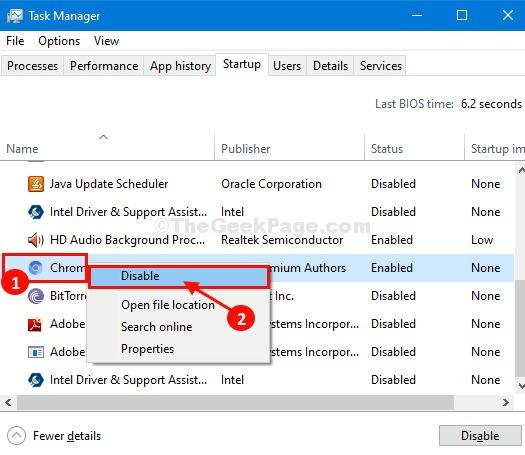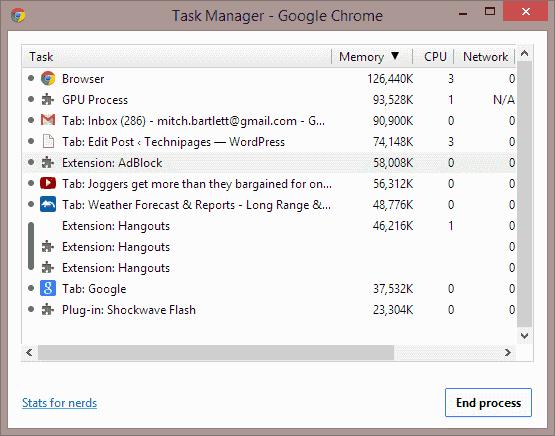
- #GOOGLE CHROME TASK MANAGER SHORTCUT WINDOWS HOW TO#
- #GOOGLE CHROME TASK MANAGER SHORTCUT WINDOWS WINDOWS#
Type a search term after the question mark to perform a search using your default search engine.Ĭtrl+G or Enter Finds the next match for your input in the find bar.Ĭtrl+Shift+G or Shift+Enter Finds the previous match for your input in the find bar.Ĭtrl+U Opens the source of your current page.ĭrag a link to bookmarks bar Saves the link as a bookmark.Ĭtrl+D Saves your current webpage as a bookmark.į11 Opens your page in full-screen mode. Closes the tab you clicked.Īlt+F Opens the Tools menu, which lets you customize and control settings in Google Chrome.Ĭtrl+Shift+B Toggles the bookmarks bar on and off.Ĭtrl+K or Ctrl+E Places a ‘?’ in the address bar. Google Chrome remembers the last 10 tabs you’ve closed.Ĭtrl+1 through Ctrl+8 Switches to the tab at the specified position number on the tab strip.Ĭtrl+Tab or Ctrl+PgDown Switches to the next tab.Ĭtrl+Shift+Tab or Ctrl+PgUp Switches to the previous tab.Ĭtrl+W or Ctrl+F4 Closes the current tab or pop-up.Ĭlick a tab with your middle mouse button (or mousewheel). Opens the link in a new tab and switches to the newly opened tab.Ĭtrl+Shift+T Reopens the last tab you’ve closed. Or press Shift and click a link with your middle mouse button (or mousewheel). Opens the link in a new tab in the background. Or click a link with your middle mouse button (or mousewheel). Here are a list of commonly used shortcuts: In case of any query related to this article, please let us know via feedback.Keyboard shortcuts of Chrome can make it easier to control the browser and save our time. With this tool, you can monitor all running processes and stop processes that are not responding.
#GOOGLE CHROME TASK MANAGER SHORTCUT WINDOWS HOW TO#
This article explained how to use the Google Chrome Task Manager.

Similarly, to sort the process containing the least amount of memory, sort the list according to the memory footprint. For example, to sort memory footprint stats, click on the heading of the memory footprint column, and the process containing the most memory will be sorted and displayed at the top of the list. You can also sort specific column stats by clicking on a column heading. To remove a category from the column list, remove the checkmark on that category.įor example, if you want to see the stats of the CPU time of each process in the column list, then you will checkmark this category. Categories that already have a checkmark are displayed in the columns. To add other resource categories in the Task Manager Columns, add a checkmark to each category you wish to add. To do this, right-click on the particular process, and you will see a list of the context menu stats. You can easily look at the resources that all the processes are using. Google Chrome has over 20 different categories of stats which you can add in the Task Manager Columns menu. View All Available Resources for Running Tasks All the processes that you selected from the list will be terminated. After highlighting the selections, click the ‘End Process’ button. To do so, for Windows, hold down the Shift or Ctrl key, and for Mac, highlight multiple processes from the list. You can also terminate or kill several processes at once. For example, if the data searching tab is not responding to you at any time, then you can easily stop this task upon selection. To perform this action, click on the process to select it and click ‘End Process’ to terminate the process. This can be useful when a tab or extension stops responding to the system. You can terminate any process from the Task Manager Menu list.
#GOOGLE CHROME TASK MANAGER SHORTCUT WINDOWS WINDOWS#
Press Shift + Esc for Windows and Search + Esc on OS Chrome.Īfter clicking ‘Task Manager,’ the following window will appear, with a list showing all extensions, tabs, and currently running processes. A drop list with more options will appear, from which you will select ‘Task Manager.’ You can also open the Task Manager through keyboard shortcut keys. To open the Google Chrome Task Manager, click on the three dots icon in the top right-hand corner, then move your cursor to the ‘More tools’ option. This article shows you how to use the built-in Google Chrome task manager on your system. Google Chrome, a popular web browser, has a resource manager that helps you monitor extensions and tabs inside the browser. You can use the task manager to terminate troublesome running processes. A task manager is used to provide complete details about the application and processes running on your system, as well as the general status of your machine.


Most operating systems have a built-in resource monitor or task manager that monitors system programs.


 0 kommentar(er)
0 kommentar(er)
